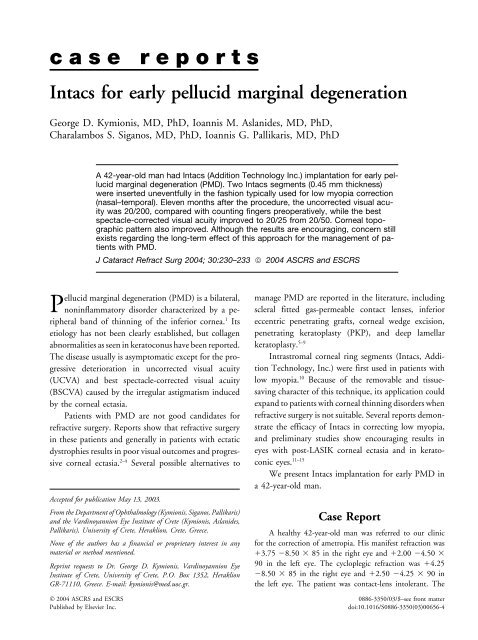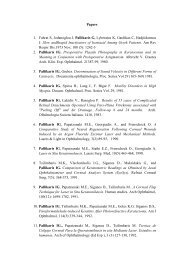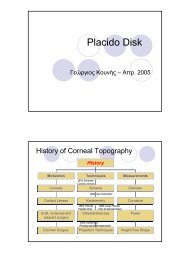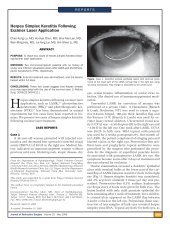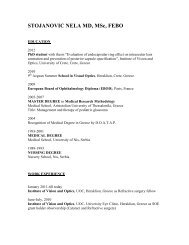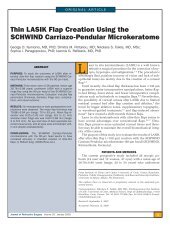Intacs for early pellucid degeneration
Intacs for early pellucid degeneration
Intacs for early pellucid degeneration
Create successful ePaper yourself
Turn your PDF publications into a flip-book with our unique Google optimized e-Paper software.
case<br />
reports<br />
<strong>Intacs</strong> <strong>for</strong> <strong>early</strong> <strong>pellucid</strong> marginal <strong>degeneration</strong><br />
George D. Kymionis, MD, PhD, Ioannis M. Aslanides, MD, PhD,<br />
Charalambos S. Siganos, MD, PhD, Ioannis G. Pallikaris, MD, PhD<br />
A 42-year-old man had <strong>Intacs</strong> (Addition Technology Inc.) implantation <strong>for</strong> <strong>early</strong> <strong>pellucid</strong><br />
marginal <strong>degeneration</strong> (PMD). Two <strong>Intacs</strong> segments (0.45 mm thickness)<br />
were inserted uneventfully in the fashion typically used <strong>for</strong> low myopia correction<br />
(nasal–temporal). Eleven months after the procedure, the uncorrected visual acuity<br />
was 20/200, compared with counting fingers preoperatively, while the best<br />
spectacle-corrected visual acuity improved to 20/25 from 20/50. Corneal topographic<br />
pattern also improved. Although the results are encouraging, concern still<br />
exists regarding the long-term effect of this approach <strong>for</strong> the management of patients<br />
with PMD.<br />
J Cataract Refract Surg 2004; 30:230–233 © 2004 ASCRS and ESCRS<br />
Accepted <strong>for</strong> publication May 13, 2003.<br />
From the Department of Ophthalmology (Kymionis, Siganos, Pallikaris)<br />
and the Vardinoyannion Eye Institute of Crete (Kymionis, Aslanides,<br />
Pallikaris), University of Crete, Heraklion, Crete, Greece.<br />
None of the authors has a financial or proprietary interest in any<br />
material or method mentioned.<br />
Reprint requests to Dr. George D. Kymionis, Vardinoyannion Eye<br />
Institute of Crete, University of Crete, P.O. Box 1352, Heraklion<br />
GR-71110, Greece. E-mail: kymionis@med.uoc.gr.<br />
Pellucid marginal <strong>degeneration</strong> (PMD) is a bilateral,<br />
noninflammatory disorder characterized by a pe-<br />
ripheral band of thinning of the inferior cornea. 1 Its<br />
etiology has not been cl<strong>early</strong> established, but collagen<br />
abnormalities as seen in keratoconus have been reported.<br />
The disease usually is asymptomatic except <strong>for</strong> the pro-<br />
gressive deterioration in uncorrected visual acuity<br />
(UCVA) and best spectacle-corrected visual acuity<br />
(BSCVA) caused by the irregular astigmatism induced<br />
by the corneal ectasia.<br />
Patients with PMD are not good candidates <strong>for</strong><br />
refractive surgery. Reports show that refractive surgery<br />
in these patients and generally in patients with ectatic<br />
dystrophies results in poor visual outcomes and progres-<br />
sive corneal ectasia. 2–4 Several possible alternatives to<br />
manage PMD are reported in the literature, including<br />
scleral fitted gas-permeable contact lenses, inferior<br />
eccentric penetrating grafts, corneal wedge excision,<br />
penetrating keratoplasty (PKP), and deep lamellar<br />
keratoplasty. 5–9<br />
Intrastromal corneal ring segments (<strong>Intacs</strong>, Addition<br />
Technology, Inc.) were first used in patients with<br />
low myopia. 10 Because of the removable and tissuesaving<br />
character of this technique, its application could<br />
expand to patients with corneal thinning disorders when<br />
refractive surgery is not suitable. Several reports demonstrate<br />
the efficacy of <strong>Intacs</strong> in correcting low myopia,<br />
and preliminary studies show encouraging results in<br />
eyes with post-LASIK corneal ectasia and in keratoconic<br />
eyes. 11–15<br />
We present <strong>Intacs</strong> implantation <strong>for</strong> <strong>early</strong> PMD in<br />
a 42-year-old man.<br />
Case Report<br />
A healthy 42-year-old man was referred to our clinic<br />
<strong>for</strong> the correction of ametropia. His manifest refraction was<br />
3.75 8.50 85 in the right eye and 2.00 4.50 <br />
90 in the left eye. The cycloplegic refraction was 4.25<br />
8.50 85 in the right eye and 2.50 4.25 90 in<br />
the left eye. The patient was contact-lens intolerant. The<br />
© 2004 ASCRS and ESCRS 0886-3350/03/$–see front matter<br />
Published by Elsevier Inc.<br />
doi:10.1016/S0886-3350(03)00656-4
CASE REPORTS: KYMIONIS<br />
Figure 2. (Kymionis) Slitlamp photograph of the right eye with<br />
<strong>early</strong> PMD after <strong>Intacs</strong> implantation.<br />
Figure 1. (Kymionis) Top: Preoperative topography of a right eye<br />
with <strong>early</strong> PMD. Bottom: The eye 11 months after <strong>Intacs</strong> segment<br />
insertion.<br />
UCVA was counting fingers in both eyes, while the BSCVA<br />
was 20/50 in the right eye and 20/32 in the left eye. Central<br />
corneal pachymetry (ultrasound, Sonogage, DGH 5100<br />
Technology, Inc.) was 550 m and 560 m in the right eye<br />
and left eye, respectively. Inferior measurements were 530 m<br />
and 550 m, respectively. Corneal topography (TechnoMed<br />
C-Scan, Technomed GmBH) revealed inferior perilimbal<br />
steepening in both eyes, more advanced in the right eye, as<br />
well as inferior elevation with an area of central corneal<br />
flattening (Figure 1, top). Corneal slitlamp examination<br />
showed no evidence of corneal thinning, iron lines, or protru-<br />
sion. Posterior segment examination in both eyes was unremarkable.<br />
A diagnosis of <strong>early</strong> PMD was made, and the<br />
patient was advised not to have refractive surgery.<br />
After the patient was in<strong>for</strong>med of possible surgical benefits<br />
and complications, he was included in a prospective<br />
clinical study of the safety and efficacy of <strong>Intacs</strong> implantation<br />
in patients with corneal ectatic dystrophies. The patient gave<br />
written in<strong>for</strong>med consent in accordance with the Declaration<br />
of Helsinki.<br />
Surgical Procedure<br />
The surgical procedure was per<strong>for</strong>med under topical<br />
anesthesia. Two <strong>Intacs</strong> segments (0.45 mm thickness) were<br />
inserted in the fashion typically used <strong>for</strong> low myopia correction<br />
(nasal–temporal). Corneal thickness was measured intraoperatively<br />
at the incision site and peripherally in the cornea<br />
with ultrasonic pachymetry along the ring placement markings.<br />
Using a diamond knife set at 70% of the thinnest<br />
corneal measurement (360 m), a 0.90 mm radial incision<br />
was made. Corneal pockets were created using 2 Sinskey<br />
hooks and a Suarez spreader. Two corneal tunnels were<br />
<strong>for</strong>med using clockwise and counterclockwise dissectors under<br />
suction created by a vacuum-centering guide. The 2<br />
poly(methyl methacrylate) segments were implanted in the<br />
respective corneal tunnels to bring them in contact at the<br />
inferior ends, aiming <strong>for</strong> maximal flattening of the inferior<br />
cornea (Figure 2). The incision site was closed using a single<br />
10-0 nylon suture. The procedure was uneventful.<br />
Postoperatively, antibiotic–steroid eyedrops 4 times daily<br />
<strong>for</strong> 2 weeks were prescribed. The patient was instructed to<br />
avoid rubbing the eye and to use preservative-free artificial<br />
tears frequently. The suture was removed 2 weeks after surgery.<br />
Eleven months after the procedure, the patient’s right<br />
eye UCVA was 20/200; BSCVA was 20/25, while manifest<br />
refraction was 4.50 5.50 85 (cycloplegic refraction<br />
5.00 5.50 85) with an improvement in corneal topographic<br />
pattern (Figure 1, bottom).<br />
Discussion<br />
Noninflammatory corneal thinning disorders (eg,<br />
keratoconus, PMD, and keratoglobus) are characterized<br />
by progressive corneal thinning, protrusion, and scar-<br />
ring, which result in visual distortion and reduction.<br />
J CATARACT REFRACT SURG—VOL 30, JANUARY 2004 231
CASE REPORTS: KYMIONIS<br />
The origin of these conditions remains unclear and may of <strong>Intacs</strong>, especially the inferior part, technically diffibe<br />
associated with a variety of factors.<br />
cult. To avoid per<strong>for</strong>ation in these cases, a thinner<br />
Pellucid marginal <strong>degeneration</strong> is an uncommon segment (0.25 mm) could be used in the inferior part<br />
<strong>for</strong>m of an idiopathic, noninflammatory peripheral of the cornea.<br />
corneal thinning disorder. Slitlamp examination is char- Another issue with this technique is the possibility<br />
acterized by a peripheral band of thinning of the inferior of stabilization and/or elimination of the progression<br />
cornea between the 4 o’clock and 8 o’clock positions. of ectatic disease. Further investigation with more cases<br />
The disease is bilateral but asymmetric in nature. In and follow-up is necessary. Additionally, the implantacontrast<br />
with peripheral corneal melting disorders (eg, tion of segments in different sites of the cornea (supe-<br />
Mooren’s ulcer or peripheral melting secondary to rheu- rior–inferior or temporal–nasal) must be examined to<br />
matological disorders), the area of thinning typically find the best corneal regions <strong>for</strong> segment implantation.<br />
is epithelialized, clear, avascular, and without lipid <strong>Intacs</strong> seem to offer a minimally invasive alternative<br />
deposits. 1,2<br />
treatment <strong>for</strong> patients with <strong>early</strong> PMD. Further studies<br />
Spectacle or contact lens correction is beneficial in<br />
are needed to draw conclusions about the efficacy of<br />
<strong>early</strong> stages of the disease. In advanced stages in which<br />
this technique in patients with PMD.<br />
spectacles or contact lenses cannot provide visual rehabilitation,<br />
invasive therapies may be considered. Standard-sized<br />
PKP and alternative techniques have varied<br />
References<br />
results. 5–9 Furthermore, the side effects of prolonged use 1. Krachmer JH. Pellucid marginal corneal <strong>degeneration</strong>.<br />
of steroids after keratoplasty dictate the application of Arch Ophthalmol 1978; 96:1217–1221<br />
2. Ambrósio R Jr, Wilson SE. Early <strong>pellucid</strong> marginal corsurgical<br />
treatment only in patients with advanced<br />
neal <strong>degeneration</strong>; case reports of two refractive surgery<br />
disease.<br />
candidates. Cornea 2002; 21:114–117<br />
In 2002, Colin and coauthors 11 published prelimi- 3. Seiler T, Quurke AW. Iatrogenic keratectasia after<br />
nary results of managing keratoconus with <strong>Intacs</strong>. A LASIK in a case of <strong>for</strong>me fruste keratoconus. J Cataract<br />
year later, they reported on a series of 10 keratoconic Refract Surg 1998; 24:1007–1009<br />
patients 1 year after <strong>Intacs</strong> implantation, 12 demonstratasia<br />
4. Schmitt-Bernard C-FM, Lesage C, Arnaud B. Keratecting<br />
that <strong>Intacs</strong> reduced corneal steepening and astigmanus.<br />
induced by laser in situ keratomileusis in keratoco-<br />
J Refract Surg 2000; 16:368–370<br />
tism while visual acuity improved in almost all eyes. The<br />
5. Biswas S, Brahma A, Tromans C, Ridgway A. Managesurgical<br />
procedure was similar to that <strong>for</strong> low myopia<br />
ment of <strong>pellucid</strong> marginal corneal <strong>degeneration</strong>. Eye<br />
correction except <strong>for</strong> the <strong>Intacs</strong> segment thickness and 2000; 14:629–634<br />
the location of the incision site. In all patients, the 6. Rasheed K, Rabinowitz YS. Surgical treatment of adauthors<br />
used a temporal incision; a 0.45 mm thickness vanced <strong>pellucid</strong> marginal <strong>degeneration</strong>. Ophthalmology<br />
segment was inserted inferiorly and a 0.25 mm thickness 2000; 107:1836–1840<br />
segment, superiorly to counterbalance and flatten the 7. Varley GA, Macsai MS, Krachmer JH. The results of<br />
overall anterior corneal surface.<br />
penetrating keratoplasty <strong>for</strong> <strong>pellucid</strong> marginal corneal<br />
<strong>degeneration</strong>. Am J Ophthalmol 1990; 110:149–152<br />
Recently, we published our experience with <strong>Intacs</strong><br />
8. MacLean H, Robinson LP, Wechsler AW. Long-term<br />
implantation in keratoconic eyes using a different surgiresults<br />
of corneal wedge excision <strong>for</strong> <strong>pellucid</strong> marginal<br />
cal approach. In our study, 13 2 <strong>Intacs</strong> segments of the <strong>degeneration</strong>. Eye 1997; 11:613–617<br />
same thickness (0.45 mm) were inserted in all eyes while 9. Schanzlin DJ, Sarno EM, Robin JB. Crescentic lamellar<br />
their positioning depended on the topographic findings. keratoplasty <strong>for</strong> <strong>pellucid</strong> marginal <strong>degeneration</strong> [letter].<br />
In this case report, we describe our successful experience Am J Ophthalmol 1983; 96:253–254<br />
with <strong>Intacs</strong> implantation in a patient with <strong>early</strong> PMD. 10. Holmes-Higgin DK, Burris TE. Corneal surface topog-<br />
raphy and associated visual per<strong>for</strong>mance with INTACS<br />
There was an improvement in UCVA, BSCVA, and<br />
<strong>for</strong> myopia; phase III clinical trial results; the INTACS<br />
the topographic findings.<br />
Study Group. Ophthalmology 2000; 107:2061–2071<br />
Several questions arise from this case report. In 11. Colin J, Cochener B, Savary G, Malet F. Correcting<br />
advanced stages of the disease, the progressive thinning keratoconus with intracorneal rings. J Cataract Refract<br />
of the inferior part of the cornea makes implantation Surg 2000; 26:1117–1122<br />
232<br />
J CATARACT REFRACT SURG—VOL 30, JANUARY 2004
CASE REPORTS: KYMIONIS<br />
12. Colin J, Cochener B, Savary G, et al. INTACS inserts <strong>for</strong> 14. Siganos CS, Kymionis GD, Astyrakakis N, Pallikaris IG.<br />
treating keratoconus; one-year results. Ophthalmology Management of corneal ectasia after laser in situ keratomi-<br />
2001; 108:1409–1414 leusis with INTACS. J Refract Surg 2002; 18:43–46<br />
13. Siganos CS, Kymionis GD, Kartakis N, et al. Management<br />
15. Kymionis GD, Siganos CS, Kounis G, et al. Manage-<br />
of keratoconus with <strong>Intacs</strong>. Am J Ophthalmol ment of post-LASIK corneal ectasia with <strong>Intacs</strong> inserts;<br />
2003; 135:64–70<br />
one-year results. Arch Ophthalmol 2003; 121:322–326<br />
J CATARACT REFRACT SURG—VOL 30, JANUARY 2004 233


